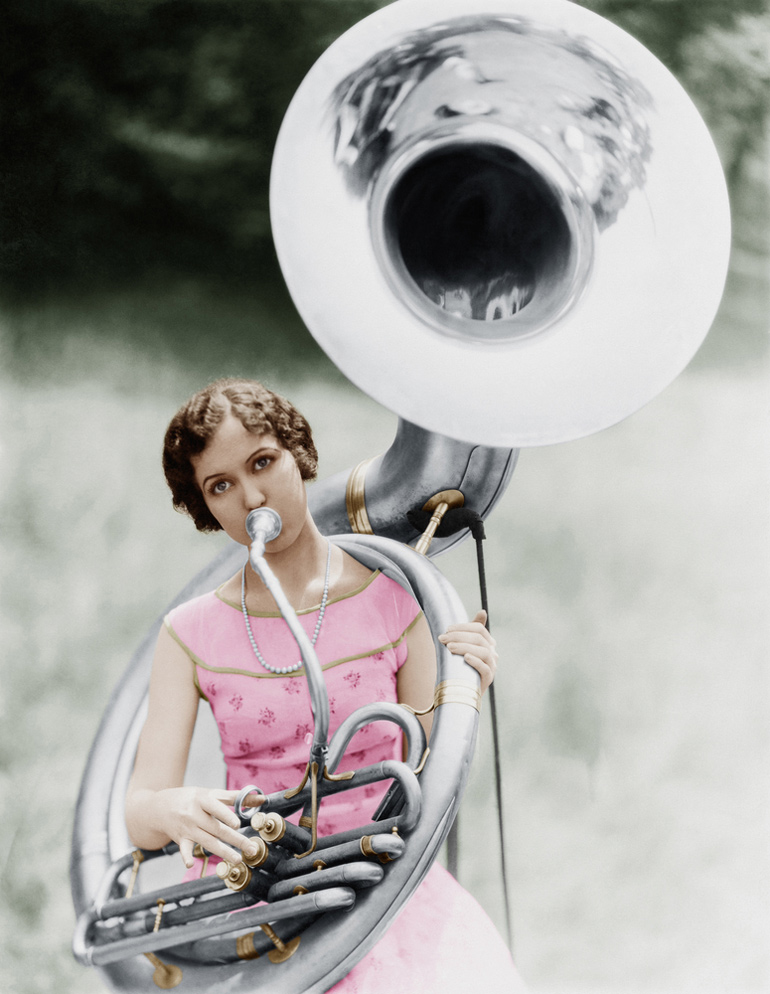
What do pants, politics, and tubas have in common? It may sound like the opening of a cheesy one-liner, but the real answer is that they were all once classified as distinctly unfeminine. They belonged to the realm of men. In mainstream Western society today, you would be hard pressed to find a person who would argue that women shouldn’t wear pants. You might find someone who would fight against a woman’s right to participate in politics but the prevailing attitude is still that the tuba, and brass instruments in general, are masculine. Though the situation is changing and female musicians who choose ‘masculine’ instruments face far less adversity than in the past, they still face gender-associations with instruments.
Numerous studies have shown that even over a span of twenty years and among participants from many different backgrounds, instruments rated on a scale of masculine to feminine remained in almost exactly the same position. As you’d probably guess, the associations are roughly drawn along the lines of size and if the instrument belongs to the woodwind or brass family. Smaller instruments, most strings, and woodwinds are perceived as more feminine, while the louder and larger brass instruments (plus double bass and percussion) are perceived as more masculine. Notable exceptions are cello, saxophone, and French horn, all of which fall somewhere in the middle. This androgyny might be due to the fact that saxophone and French horn both straddle the line between woodwind and brass, while the cello’s softer sound offsets its larger size.
Despite these associations, women have been playing brass instruments since the mid-1860s, though their participation is more or less forgotten in a historical discourse written mostly by men. Much of the rich history comes from America in the post-Civil War years when women’s bands – both amateur and professional- flourished. Before radio and TV came along to provide entertainment, town bands, as well as bands representing the military, ethnic groups, industries and families were popular activities for leisure. While bands at this time were still segregated, there are photos of all female brass bands dating back to as early as the 1870’s. These bands co-existed with such famous bands as Gilmore’s Band and the Sousa Band. One in particular, Helen May Butler’s Ladies Brass Band, may have been nearly as prevalent, if remaining articles and advertisements are any indication.
Professional women’s bands also existed. C. G. Conn, an instrument manufacturer, used a ladies’ band to promote their products and also increase interest for girls in the newly emerging school band programs. During World War II, legislation was passed allowing the creation of the Women’s Army Auxiliary Corps, and eight all-female military bands. After the war the bands were decommissioned, and the bands became predominately male again, though these bands continue to employ women.
In contrast to bands, professional orchestras have a much longer history of all-male ensembles, and there are several cases of sexist discrimination in the hiring process. The introduction of screened auditions in the middle of the 1900’s was responsible for approximately 30% of women as new hires in orchestras, as they could no longer be eliminated based on their sex. The number of women playing masculine-typed instruments in professional orchestras is still quite low, however, more female students are choosing to learn these instruments. It’s unclear if this shift is due to subsiding gender stereotypes or increased participation of girls in music programs in general, but the increased number of female low brass students has yet to even out the numbers in the professional world.
Speaking from the perspective of a female tuba player, I get the sense that the future is bright. While I’m still frequently the only woman in the low brass section and older people still sometimes comment “that’s a big instrument for a such a little girl!” (and at 5’7, I think I’m hardly considered ‘little’), attitudes are becoming more and more progressive all the time. There are many resources available for female musicians, from the International Women’s Brass Conference to all-female ensembles. Legislation is in place to combat sexual discrimination and there are now numerous examples of visible and successful female low brass players, both in and out of professional orchestras. Statistics indicate that more and more girls are choosing to play ‘masculine’ instruments despite the gender associations. Hopefully, soon, we can move past restrictive gender bias and any student, female or male, who wants to play an instrument will be able to do so without bumping up against these stereotypes.
#LUDWIGVAN
Want more updates on Toronto-centric classical music news and review before anyone else finds out? Get our exclusive newsletter here and follow us on Facebook for all the latest.
- FEATURE | How Classical Music Is Taking On Climate Change - February 11, 2020
- GUIDE | A Tour of Glenn Gould’s Toronto (Or, How I Visited Three Fran’s Locations In One Day) - January 21, 2020
- FEATURE | Classical Horoscopes: The Signs As Composers - January 4, 2020



